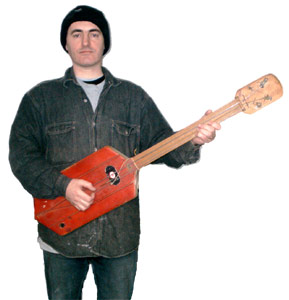Floorboard Bass
 It
started out as an experiment - I'd been talking to people about electric guitars,
just got past that stage where I thought you plugged it into the mains, and
could only play twelve notes on it…and got to wondering how, if you
plugged it into an amplifier, the sound got from the strings into becoming
an electrical signal.
It
started out as an experiment - I'd been talking to people about electric guitars,
just got past that stage where I thought you plugged it into the mains, and
could only play twelve notes on it…and got to wondering how, if you
plugged it into an amplifier, the sound got from the strings into becoming
an electrical signal.
Seemed most likely to me that the pickup was not a microphone (as I'd originally thought, in a logical way if you have nothing else to go on) but an electromagnetic device, reacting to the field change caused by the moving ferromagnetic material of the stings.
To test the theory I got three little round speaker magnets and glued them in a row onto a thin aluminium plate and wound loads of copper wire around it. Connected it up to the DIN socket on the front of the record player and established that sound would come out of the speakers if something metallic was whizzed past the pickup.
To confirm my findings I needed a string so I got the inner section of a bicycle brake cable and stretched it across the pickup along the length of a piece of floorboard, retained by a nail at one end and something at the other end to wind up the tension.
Ker-twang!
Things were working very nicely, particularly as the relative output level of the pickup and the input sensitivity of the record player resulted in a grungey overload which gave useful sustain and character to the twang of the brake cable.
I decided to narrow the floorboard at one end to make it possible to finger the string, and to add three more stings. I attached the off-cuts at the body end to make the thing look a little for normal and fitted Meccano parts as ersatz machine heads to allow adjustment of the string tension. There were no frets and the thing was never remotely in tune. I altered the thickness of the strings by unwinding strands from each bundle to approximate what I'd seen of bass guitars on TV. The resulting spiral shaped strings were not great sounding. To reduce finger wear I wound cotton around them which improved the feel of things, though it frayed away pretty quickly.
Eventually I got some dreadful Woolworth's Audition bass guitar strings when they closed down their range of musical equipment and were selling off the accessories cheap. I couldn't get all the right sizes and they were flat wound and a bit crummy to play, but less damaging to the digits than the brake cables.
I tried to put some of these awful strings onto the awful acoustic guitar mentioned in connection with the old valve tape recorder, deciding three was about all the width and strength of the neck could withstand. I thought the frets might allow actual musically related notes to come forth, but, the results were awful. Can't think why.
By this time I was in paid employment and when I was offered a second hand Jazz Bass copy I jumped at it. In the swirling madness of our early cassette recordings the floorboard bass may possibly be heard, though I can't recall where; all the decently recorded material has the copy Jazz Bass on it (or no bass at all). [I'm fairly sure that the track Plugs And Sockets on Eating People is the only recorded evidence of the floorboard bass - Mark]
The Jazz Bass was stolen from a practice room in West London along with the Drum Machine Mk 2 not long after the demise of the band. I still have the floorboard bass though, despite leaving various instruments behind at various times when housing difficulties faced me with tough choices to make.
It's a reminder of what can be done with almost no tools, no materials, and no sense of embarrassment.
Pictures of the floorboard bass in detail:
| Body | Bridge | Head |